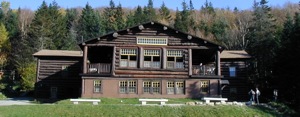The Moosilauke Advisory Committee recommends that Dartmouth demolish the historic Moosilauke Ravine Lodge (Richard Butterfield, 1938-39) near Warren, New Hampshire.
The article on the Committee’s recommendation in The Dartmouth does not suggest that the Committee has consulted with an accredited preservation architect, or an architect who is familiar with historic log buildings. The reasons given for demolishing Dartmouth’s most unusual and most sustainable building are not yet very convincing:
Reason :: Typical solution
logs cracking :: seal them
logs rotting :: replace them
current building codes :: upgrade/overlook – most old buildings fail
not large enough :: add on by extending the Great Hall
The idea that the building was “built to last 50 years” is especially insidious because every building has such a number. No one in 1938 planned for Moosilauke to be demolished in 1988 any more those who built Moore or Berry in 1998 planned to have it torn down in 2048. A “lifetime” number exists for every building and simply describes the period after which significant elements will need replacement. Swapping out logs or replacing a roof is nothing a competent construction crew cannot handle.
Dartmouth should not let the cost of proper maintenance justify destruction, even if an historic log building might cost a bit more to maintain than the cheap imitation that would replace it. The Lodge was built by volunteers and low-paid local loggers, during the Depression, which means that Dartmouth has been enjoying the savings of a low initial purchase price for 70 years. A little extra expense today would be well justified.
Destroying the Ravine Lodge would also waste all of the energy the building embodies, and by rights it should prevent any replacement from claiming to be “green.” The Lodge was constructed using sustainable local timber hauled by horses. All of its systems are indefinitely replaceable and will not tie up valuable metals or harmful chemicals in landfills when they are thrown away after failing suddenly at the end of their useful lives, as the parts of a new building will do.

The college that is gearing up to celebrate the centennial of its Outing Club, that is sincerely dedicated to meeting voluntary “green” regulations, and that produces graduates such as William McDonough should be embarrassed to consider destroying the Moosilauke Ravine Lodge. Just as with any other National-Register eligible building, if parts of it are broken, they need to be fixed. Before any demolition takes place, I’d hope that Dartmouth justify such a decision by reporting no that federal and state historic preservation laws will be implicated; that a certified preservation architect with log building experience has written off the building; and that the replacement will not seek any kind of LEED certification.
—–
[Update 01.13.2013: Broken link to McDonough removed.]
[Update 11.17.2012: Broken links to McDonough and image fixed.]

